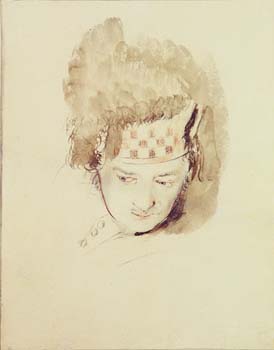Study for the Highlander
- ca. 1835
- Sir David Wilkie (Scottish/British 1785-1841)
- Graphite and watercolor study for General Sir David Baird Discovering the Body of the Sultaun Tippoo Sahib after having Captured Seringapatam, on the 4th May, 1799, painting ca. 1835-1838
25.3 x 19.9 cm., 9-15/16 x 7-13/16" sheet
- Lent Courtesy of Dr. Thomas B. Brumbaugh Art History Collection through Catherine Carter Goebel, Paul A. Anderson Chair in the Arts

Essay by Lisa Johnson, Class of 2008 and Catherine Carter Goebel, Editor
The great Scottish painter, David Wilkie (1785-1841), first studied under John Graham in Edinburgh and later trained at the Royal Academy, elected a full academician in 1811 (Chiego xvii). Wilkie primarily created genre paintings, which established his reputation, and reflect the British love for storytelling and character sketches. Wilkie also produced a large number of history paintings. These works, considered by academics to be more elevated in stature than genre, probably better reveal his Romantic temperament. In such works, he employed rich color and drama, often reflecting his strong interest in exotic lands-particularly evident in the subject of one of his last great history paintings, Sir David Baird Discovering the Body of Sultaun Tippoo Saib (1839), for which this drawing is a study.
The rising interest in exotic people and places greatly affected Romantic artists like Wilkie. This exquisite study, made of graphite and watercolor, is a portrait of the face of the Scottish torchbearer. It is mostly sketched in black, but enriched by the subtle hint of red outlining the eyes, nose, mouth and jaw in order to emphasize his facial features. The angle of the man's head adds dimension to the piece in that he looks as if he is coming out at the viewer and at the same time looking down at the defeated enemy.
In a letter to Lady Baird, Wilkie described this character as "the Highlander stooping with the torch" (Chiego 254). And when the painting was exhibited at the Royal Academy in 1839, the catalogue further defined the importance of this figure in the overall composition: ".in front, on the General's left hand, bending forward with a torch is a Highlander, a McLeod of the old 71st [the Highland Light Infantry] who, with his comrades on leaving the trenches, were reminded by the General of the old scores they had now to settle for the severe imprisonment they had formerly endured as captives at Seringapatam" (Chiego 256).
The great care that Wilkie took in capturing the personality and physical appearance of his subject is sensitively rendered in this drawing. Examining such sketches reveals the artist's steps and invites the viewer to make connections between the study and the final piece, much like fitting the pieces of a puzzle together. In this manner, drawings help viewers see the breakdown of an artist's thought process as well as the time and planning that went into each work of art.
Wilkie, along with landscape painters, John Constable (web gallery 67) and Joseph Mallord Turner, was estimated in his own time as one of the three greatest Romantic British artists of the first half of the nineteenth century. He was a close friend to Constable and a more distant acquaintance and competitor of Turner. His own short life likely best exemplifies Romantic myth-dying young on his return from the Middle Eastern journey on which he embarked the year after exhibiting this painting.
